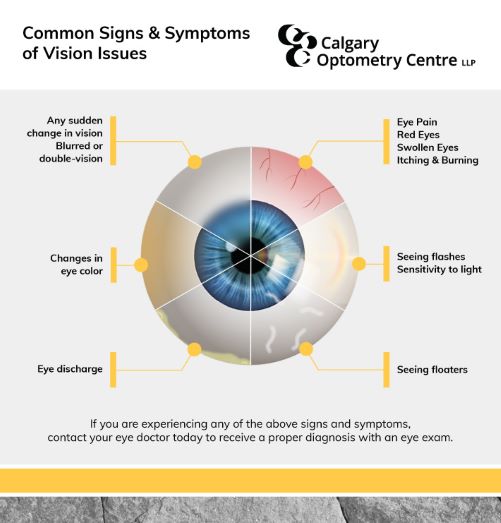Our eyesight is important. Every day, over 80% of what we perceive is through our sight. You may not notice just how important your visual health is until there is an issue. But what do you do if you are experiencing vision symptoms?
The best thing you can do is book an appointment with your optometrist to get your eyes examined. If necessary, your eye doctor can diagnose your issue and help you manage your symptoms.
Until then, learn about the most common eye diseases, disorders, and issues and the steps you can take to protect your vision.

Common Vision Symptoms
Some common signs and symptoms of vision problems include:
- Eye pain in or around the eye
- Blurred or double vision
- Seeing flashes of light or halos around lights
- Seeing “floaters”
- Sensitivity to light
- Red eyes
- Swollen eyes
- Changes in eye colour
- Itching or burning
- Eye discharge
- Any sudden change in vision
If you are experiencing any of the above symptoms, contact your eye doctor.
The 7 Most Common Eye Diseases & Disorders
Refractive Errors
A refractive error is a very common eye disorder that stops the eye from focusing properly on images. Refractive errors cause blurred vision and can sometimes lead to visual impairment.
Refractive errors include conditions such as:
- Near-sightedness: causes difficulty in seeing distance images
- Far-sightedness: causes difficulty in seeing close images
- Astigmatism: causes distorted vision
- Presbyopia: leads to difficulty in seeing at an arm’s length
Refractive errors cannot be prevented, but they can be treated with corrective eyewear or refractive surgery.
Age-Related Macular Degeneration
Age-related macular degeneration (AMD) is an eye disorder that results in the loss of sharp and central vision. Losing central vision can cause blurred vision and can make daily tasks difficult to perform.
There are two forms of AMD:
- Dry AMD is the more common form of AMD. It occurs when the macula thins, which is a normal part of the ageing process and will continue to slowly progress.
- Wet AMD occurs when there is bleeding or fluid leakage underneath the macula which can lead to central vision loss.
Cataracts
Cataracts is a clouding of the eye’s lens, which can cause vision loss and even blindness. In fact, it is the leading cause of blindness worldwide.
Cataracts can occur at any age, and there are several different causes. Cataracts can be treated with corrective eyewear if caught early during an eye exam. If a cataract has progressed too far, cataract surgery is the only treatment available.
Diabetic Retinopathy
Diabetic retinopathy (DR) is a common eye condition that is a complication of diabetes. It is caused by damage to the blood vessels of the retina which are needed for proper vision.
DR typically progresses through the four following stages:
- Mild nonproliferative retinopathy
- Moderate nonproliferative retinopathy
- Severe nonproliferative retinopathy
- Proliferative retinopathy
DR usually affects both eyes but in some cases can affect just one eye.
Glaucoma
A glaucoma is a group of eye diseases that cause damage to the optic nerve. It occurs when the normal fluid pressure inside the eyes slowly rises which can result in vision loss and blindness. Fortunately, if caught early enough, you may be able to slow the progression of the disease.
There are two major types of glaucoma:
- Open-angle glaucoma progresses slowly over time. Symptoms may go unnoticed until the disease has advanced to a severe level.
- Angle-closure glaucoma can appear suddenly and progresses quickly.
Amblyopia
Amblyopia, also known as “lazy eye,” is a common eye condition in children. Amblyopia occurs when both eyes are not working at the same efficiency. Usually your eyes both look normal from the outside, but one eye is often being favoured.
Amblyopia can be treated with corrective eyewear or surgery. If left untreated it will persist into adulthood and can cause vision impairment.
Strabismus
Strabismus is an eye condition where the eyes are positioned differently. Strabismus can cause the eyes to:
- Cross in
- Turn out
The causes of strabismum are still widely unknown but can usually be treated with an eye patch, corrective eyewear or surgery.
What to Do If You Think You have a Vision Issue
If you have any of the symptoms previously mentioned, you should contact your eye doctor and explain your symptoms.
Your eye doctor can perform an eye exam and check for any signs of common eye diseases and conditions.
If you have any questions about your eye health, contact us at the Calgary Optometry Centre today!




